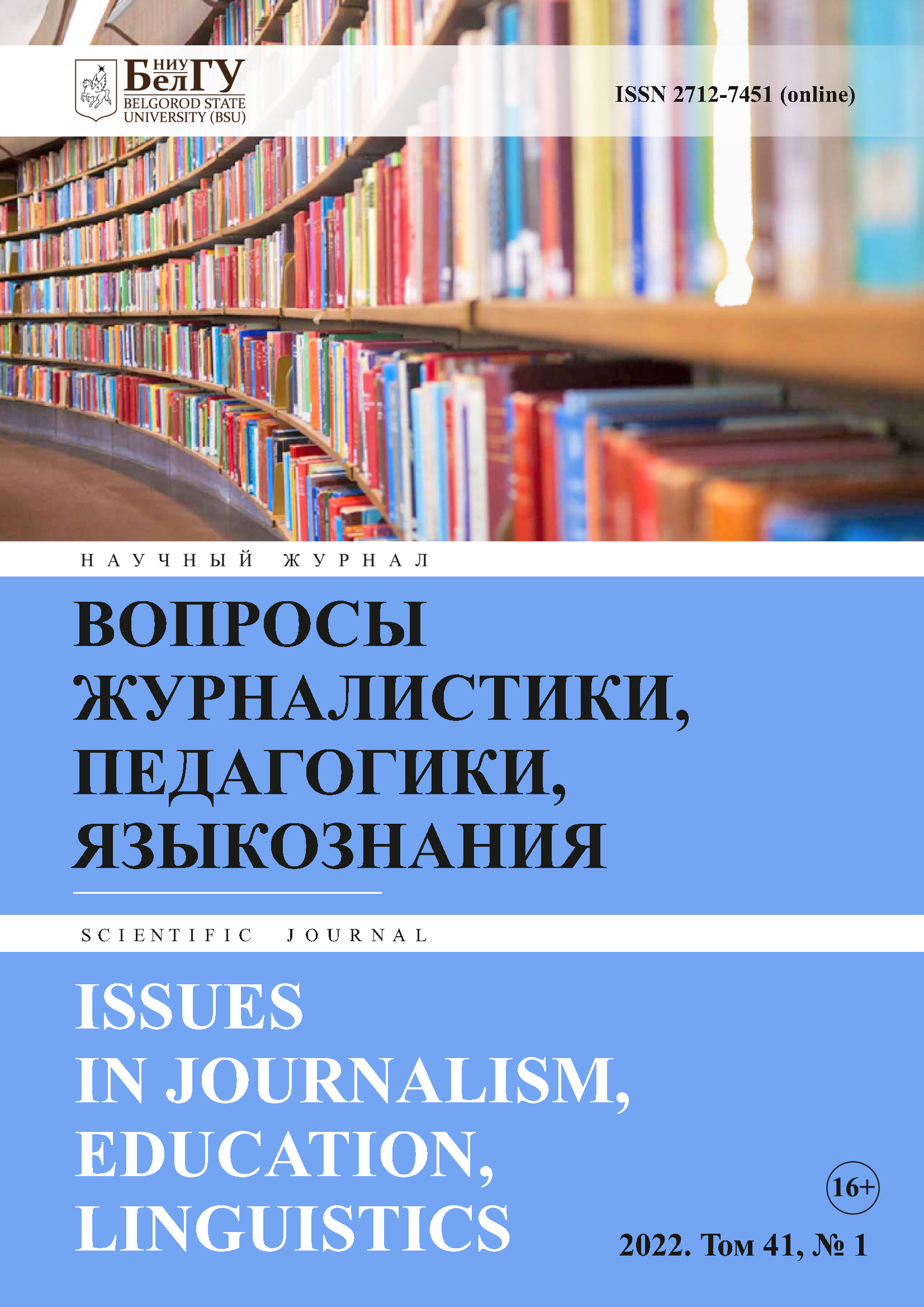Representation of a Non-verbal Communication Code in the Publicistic Discourse of Dan Bilefsky and Ellen Barry (based on “The New York Times”)
DOI:
https://doi.org/10.52575/2712-7451-2022-41-1-156-165Keywords:
publicistic discourse, “The New York Times”, gender, Dan Bilefsky, Ellen Barry, non-verbal communication, proxeme, сhroneme, senseme, kineme, takemeAbstract
This article presents the results of the analysis of non-verbal communication markers using the example of the publicistic discourse of Dan Bilefsky and Ellen Barry in the popular American newspaper “The New York Times” in the “World” section, dedicated to the distribution of relevant information about events from around the world. The high frequency of markers of non-verbal communication was revealed. In both male and female publicistic discourse, the most numerous nominees are proxemes. It has been established that chronemes are used less frequently, but with a fairly high frequency. In the mass-media discourse of Dan Bilefsky and Ellen Barry, the mid-range nominees are sensemes and kinemes. Takemes are low-frequency markers of non-verbal communication. The conclusion is made about a comparatively more frequent use of proxemes in the publicistic discourse of Dan Bilefsky, and sensemes as well as kinemes in Ellen Barry’s one. The quantitative indicators of the frequency of use of chronemes and takemes by the journalists have an insignificant difference.
References
Barry E. 2011. A Dress Code For Russians? Priest Chides Skimpiness. The New York Times, Jan. 18, 2011. Available at: https://www.nytimes.com/2011/01/19/world/europe/19russia.html (accessed: 04.09.2021)
Barry E. 2014. Matriarchs’ Duel for Power Threatens to Tilt Bangladesh Off Balance. The New York Times, Jan. 11, 2014. Available at: https://www.nytimes.com/2014/01/12/world/asia/matriarchs-duel-for-power-threatens-to-tilt-bangladesh-off-balance.html (accessed: 04.09.2021).
Barry E. 2017. India’s ‘Phone Romeos’ Look for Ms. Right via Wrong Numbers. The New York Times, March 24, 2017. Available at: https://www.nytimes.com/2017/03/22/world/asia/indias-phone-romeos-look-for-the-right-one-through-wrong-numbers.html (accessed: 04.09.2021).
Barry E. 2018. In Sweden’s Preschools, Boys Learn to Dance and Girls Learn to Yell Numbers. The New York Times, March 24, 2018. Available at: https://www.nytimes.com/2018/03/24/world/europe/sweden-gender-neutral-preschools.html (accessed: 04.09.2021).
Bilefsky D. 2005. Migration's Flip Side: One Big Empty Nest. The New York Times, Dec. 12, 2005. Available at: https://www.nytimes.com/2005/12/12/world/europe/migrations-flip-side-one-big-empty-nest.html (accessed: 04.09.2021).
Bilefsky D. 2006. Polygamy Fosters Culture Clashes (and Regrets) in Turkey. The New York Times, July 10, 2006. Available at: https://www.nytimes.com/2006/07/10/world/europe/10turkey.html (accessed: 04.09.2021).
Bilefsky D. 2010. Women’s Influence Grows in Bulgarian Public Life. The New York Times, Feb. 7, 2010. Available at: https://www.nytimes.com/2010/02/08/world/europe/08iht-bulgwomen.html (accessed: 04.09.2021).
Bilefsky D. 2014. E.U. Labor Market Opens for Romanians and Bulgarians. The New York Times, Jan. 1, 2014. Available at: https://www.nytimes.com/2014/01/02/world/europe/european-labor-market-opens-for-romanians-and-bulgarians.html (дата обращения 04.09.2021).
Bilefsky D. 2018. Canadians Greet Bombardier Decision With Pride and a Little Snark. The New York Times, Jan. 11, 2018. Available at: https://www.nytimes.com/2018/01/27/world/americas/canada-bombardier-trump.html (accessed: 04.09.2021).
Абишева В.Т., Maдетхан Р.С. 2018. К вопросу о коммуникативных и когнитивных аспектах публицистического дискурса. Bulletin of L.N. Gumilyov Eurasian National University. JOURNALISM Series, 4 (125): 19–24. DOI: 10.32523/2616-7174-2018-125-4-19-24
Алефиренко Н.Ф. 2009. «Живое» слово: проблемы функциональной лексикологии. М., Флинта, 344 с.
Алиева Д.А., Оналбаева А.Т. 2019. Отражение лингвокультуры казахов в проксемике. Вестник Казахстанско-Британского технического университета, 3 (50): 437‒442.
Даниленко И.А. 2016. Репрезентанты невербального кода коммуникации в номинативном поле концепта. Международный журнал экспериментального образования, (4-2): 327‒330.
Кузьминых Ю.А., Огнева Е.А. 2013. Репрезентация проксем в когнитивно-дискурсивном контуре художественного текста. Современные проблемы науки и образования, (3): 383. URL: https://s.science-education.ru/pdf/2013/3/400.pdf (дата обращения: 04.09.2021).
Лущинская О.В. 2019. Дискурс конвергентных средств массовой коммуникации как разновидность медийного дискурса. В кн.: Журналістыка - 2019: стан, праблемы і перспектывы, Матэрыялы 21 медународнай навукова-практычнай канферэнцыі. Мінск, 14–15 ліст. 2019 г. Пад рэд. В.А. Самусевіч. Минск, БДУ: 440‒444.
Огнева Е.А. 2013. Темпоральная архитектоника концептосферы художественного текста. В кн.: Приоритетные направления лингвистических исследований: общетеоретические, когнитивные, коммуникативно-прагматические и функционально-грамматические аспекты языка. Под ред. А.Г. Бердниковой. Новосибирск, СибАК: 138‒155.
Огнева Е.А., Даниленко И.А. 2021. Дуальность художественного концепта как текстовый информативный код. М., Эдитус, 208 с.
Berger A.A. 2016. A Discourse on Discourse Studies. Society, 53 (6), 597–602. DOI: 10.1007/s12115-016-0071-z
Burgoon J.K., Guerrero L.K., Floyd K. 2016. Nonverbal communication. Taylor and Francis, 509 p. DOI:10.4324/9781315663425
Harrison R.P. 1989. Nonverbal communication. In: Human Communication as a Field of Study: Selected Contemporary Views. Ed. S.S. King. State University of New York: 113-126.
Knapp M.L., Hall J.A., Horgan T.G. 2013. Nonverbal communication in human interaction. Boston, MA: Cengage Learning, 528 p.
Ezaka S., Emechebe N.C. 2018. Nonverbal and Subliminal Communications in Media Convergence: A Perspective. IOSR Journal of Humanities and Social Science (IOSR-JHSS), 23 (7): 9‒16. DOI: 10.9790/0837-2307010916
O’Keeffe A. 2011. Media and Discourse Analysis. In: The Routledge Handbook of Discourse Analysis. Eds. J. Gee, M. Handford. London, Publ. Routledge: 441–454.
Tiechuan M. 2016. A Study on Nonverbal Communication in Cross-culture. Asian Journal of Humanities and Social Sciences (AJHSS), 4 (1): 1-6. Available at: http://ajhss.org/pdfs/Vol4Issue1/1.pdf (accessed: 04.09.2021).
Watson O.M. 2019. Proxemics as non-verbal communication. In: Man, Language and Society: Contributions to the Sociology of Language. Ed. S.K. Ghosh. Berlin, Boston, De Gruyter Mouton: 224‒231. DOI: 10.1515/9783110905281-015
Yarlott W.V., Cornelio C., Gao T., Finlayson M. 2018. Identifying the Discourse Function of News Article Paragraphs. In: Proceedings of the Workshop Events and Stories in the News 2018., Santa Fe, New Mexico, USA: 25‒33.
Abstract views: 211
Share
Published
How to Cite
Issue
Section
Copyright (c) 2022 Наталия Алексеевна Трофимова

This work is licensed under a Creative Commons Attribution 4.0 International License.


